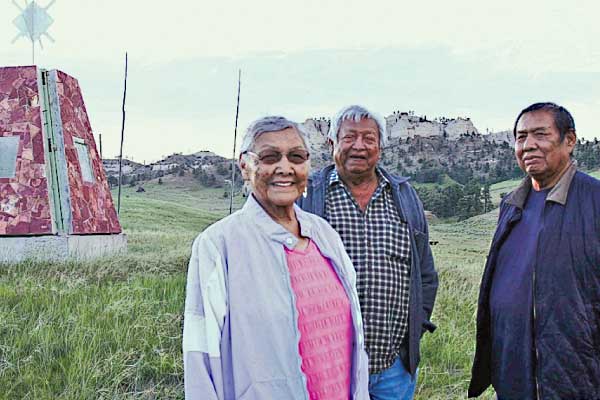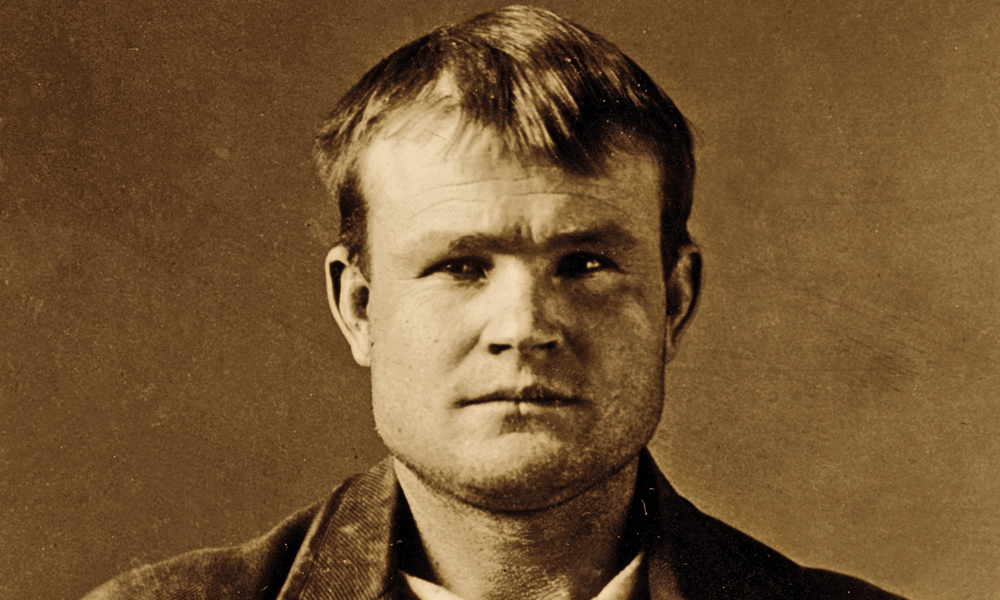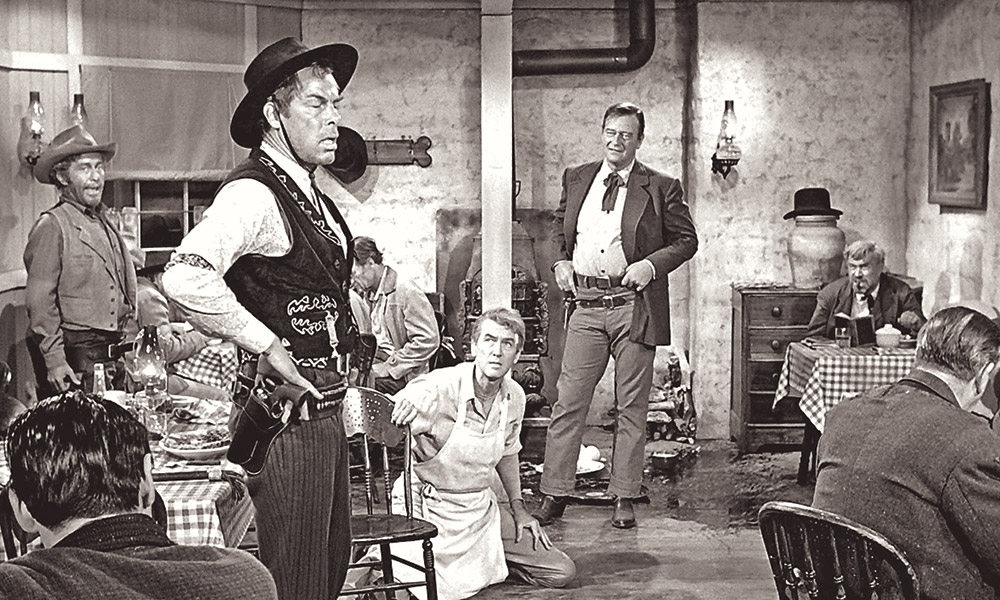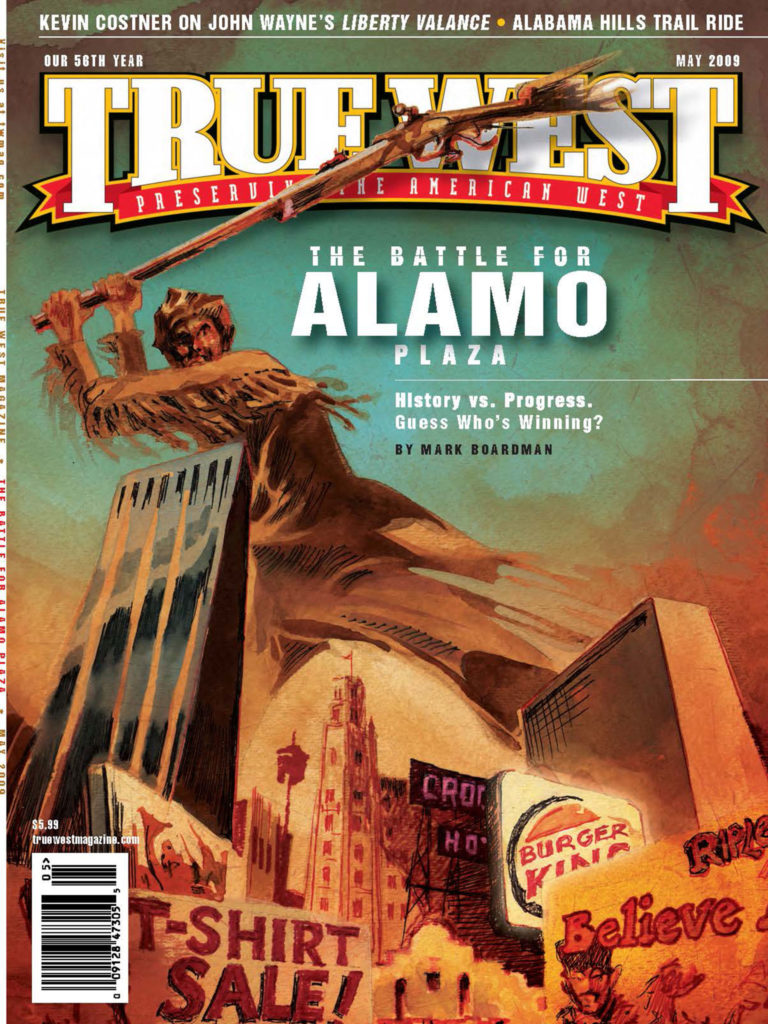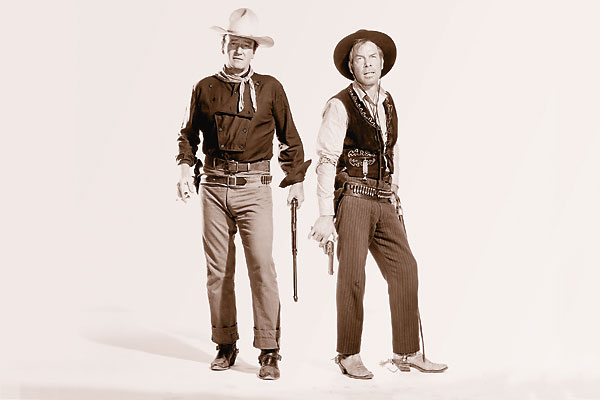
The Man Who Shot Liberty Valance (1962) is the last truly important movie in the career of director John Ford.
As Liberty Valance begins, the period we see in the film is roughly the same time that Ford first began making Westerns, in the second decade of the 20th century. But the bulk of the story is a flashback that takes us to the 1870’s, when most of the great Westerns, including Ford’s, take place.
The flashback is a re-telling of events leading up to the defining moment in the life of an Eastern tenderfoot, Ransom Stoddard (played by James Stewart), who arrived by stagecoach in Horace Greeley’s West with a carpetbag full of law books and untested principles. Immediately upon his arrival, Stoddard is beaten to within an inch of his life by one gunfighter, Liberty Valance (Lee Marvin), and then rescued by another.
The picture never establishes an exact state, but we do learn the town is called Shinbone and that the majority of citizens who live here are launching a fight for statehood against the wishes of the cattle barons who first settled the place. Stoddard has arrived at a key moment. Although his legal expertise is valuable, we can see that law books don’t mean much when he’s eventually forced to face Valance in a fight to the death.
That showdown, and Valance’s death, pushed the lawyer into prominence, making it possible for Stoddard to revisit Shinbone decades later, as a three-term governor and two-term senator.
We meet Stoddard and his wife Hallie (Vera Miles) as they arrive by train to honor the death of Tom Doniphon, an unseen figure laid out in a pine box who has but a single mourner.
When the editor of the local paper gets wind of the arrival of Sen. Stoddard, he forces an audience, demanding to know why so prominent a figure would travel so far to honor a man who nobody but a handful of the local old timers knew. With a nod of encouragement from his wife, Stoddard decides to give them what they want, and maybe a little bit more.
The film is often described as a Mystery, but that’s inaccurate. What this Western has is a key plot twist that changes the established facts of Stoddard’s life, and the late Tom Doniphon (John Wayne) is at the core of it all.
Ford’s frequent collaborations with John Wayne—The Searchers, Stagecoach, the cavalry trilogy—are defining moments for Wayne, Ford and the Western in general, which is why Liberty Valance, so late in his career and his next-to-last Western before Cheyenne Autumn, is so crucial.
A line in the picture gets quoted often, even by those who have never seen the movie. When Stoddard finishes telling the Shinbone paper the actual truth about Liberty Valance’s death, the editor tears the story in half and throws it into the stove. “This is the West, sir,” he says. “When the legend becomes fact, print the legend.”
As an audience, we’re left wondering whether Ford is either justifying, or criticizing, an entire lifetime spent building our idea of the West. After years of wondering about Ford’s feelings on the subject, we’re left without an answer. What’s clear is that Liberty Valance is a bittersweet look at the West, and that the film raises as many questions as it answers.
The picture is also tremendously affecting and entertaining, which isn’t surprising since all of Ford’s considerable skills as a filmmaker went into it.
Liberty Valance was shot relatively inexpensively in black and white (Ford’s desire, say some. Budget problems, say others) and lacks any of Ford’s trademark landscapes and poetic exteriors.
Wayne reportedly took the part of Doniphon grudgingly, unhappy that his role was smaller than what he was used to and because he didn’t “get the girl.” It’s not hard to imagine that Wayne, who took his screen persona very personally, was disinclined to play a character who disintegrates physically and emotionally on screen and, as Woody Allen might say, in such small portions. Some of the material that’s surfaced in biographies claim that Wayne was encouraged to take the part because Doniphon had “ambiguities,” pretty much the rage in those method acting-crazy days, but that wasn’t Wayne bait. “Perversion and corruption masquerade as ambiguity,” he once said. “I don’t trust ambiguity.”
It’s a good thing Wayne had someone like Ford around to occasionally shake him out of his chowderheaded notions of who he was and what he should and shouldn’t be caught doing on screen. Liberty Valance is one of his best performances and one of the strongest moments in his entire career.
As Stoddard, Stewart is a kind of twitchy, good-intentioned innocent who manages to represent an inevitable and necessary civilizing element that will make the West livable. He also represents the triumph of talk over action, of compromise, of making life safe. Stoddard’s purpose is to make the Doniphons and Valances obsolete … and he succeeds. But we don’t watch Westerns to see folks going about their daily business in an orderly fashion.
That’s where Lee Marvin comes in. His character Valance is so good and so completely evil that Marvin nearly steals the film from Wayne and Stewart, the same way that he stole The Wild One from Marlon Brando a few years earlier. Marvin is only on screen in a few scenes, but the impression he makes in the beginning is so powerful that his name alone sends waves of dread through the folks in the picture and the folks watching the picture. The brief confrontation between Valance and Doniphon that takes place in a restaurant is something that Western lovers will never, ever forget.
Here’s the final kicker: Even though Liberty Valance is a movie about Westerns and Western myth, what makes the movie truly endure is the tragic heartbreak that Wayne’s character Tom Doniphon suffers when he comes to realize that Hallie, the woman he’s been courting, and counting on, is now fixing her gaze at the whiny carpetbagger he had the bad luck to rescue in the beginning of the story.
When we first see the coffin, that impossibly tiny box in that stuffy windowless room, we’re not mourning the death of the Wild West. It’s Doniphon, offscreen, who breaks our hearts, a man shrunken and made smooth by decades of slow erosion.
Stoddard demands that Doniphon’s boots and spurs and gunbelt be returned to his corpse. It turns out he hadn’t worn a handgun in years. And Hallie, who is the secret driver of the events in the story, places a single cactus rose on Doniphon’s coffin while her husband is elsewhere, talking to the press and “mending a few political fences.”
Ford may have had a lot he wanted to communicate in his last great Western, but in the end, he made a picture about grief.
Costner on Valance
Beginning with Silverado (1985), Kevin Costner has never been far from one Western project or another, and Dances With Wolves (1990), which he produced, directed and starred in, is one of only three Westerns to win a Best Picture Academy Award. Costner also starred in Wyatt Earp (1994), and his film Open Range (2003) is considered to be a modern classic. In fact, his infant son Hayes is named after a character in a Western he plans to make.
The Man Who Shot Liberty Valance is among Costner’s favorite Westerns. He’s even sung the theme song (it never played in the film) with his band Modern West.
TW: I see you’ve been including the song “The Man Who Shot Liberty Valance” in some of your live music sets. There’s a YouTube performance—
KC: Yeah, probably from somebody’s iPhone. But, yeah, I sang it to a couple of friends, Lute Olson, the [retired University of Arizona] basketball coach in Tucson, who suffered a stroke, and just ’cause it’s an homage to guys who really kinda go their own way.
Do you mean the lyrics, or—
I just think the movie itself, Liberty Valance, the idea of heroism, of standing up for yourself.
Are you talking about the character of Ransom Stoddard or Tom Doniphon?
Well, both. Everybody has to stand up.
Liberty Valance, I find, is a film to take apart and re-examine.
I would say so. The interesting thing is that it’s not a movie that’s beautiful, in the sense that the town is a stage town, built on a sound stage, and it’s not a beautifully rendered movie, so it has all the trappings that are going against it, except it’s such a superior story that it reminds you that the play still is the thing.
What about the story draws you in?
The subtleties of it are what are so important to me: that John Wayne is losing a woman—he ain’t gonna get this woman—and inside the black hat/white hat of Westerns to see the drama and pain that this woman is shifting, that this other man has something that he’ll never have.
It’s also when Wayne is most effective, to be honest, when he doesn’t always have to carry the whole film. It’s not that he couldn’t carry films, but you see him in Fort Apache with [Henry] Fonda and when he is kind of in a secondary role, and he’s very formidable.
I like three-hour movies and I like subplots, so I like the idea that there’s this political life and the simplicity that, when Jimmy Stewart’s character is at the coffin and there’s that cactus, the yellow rose, there’s a lot of poetry. I love the poetry of Westerns. People go “What?” Yeah. “How can you like the poetry and like the violence?” It’s like, that’s what I love about it. I love the randomness of violence and the poetry. I think Lee Marvin was not a convenience for any hero to knock down. He was a formidable person. That scene over the steak is probably one of the best pieces of writing that you could ever see.
Why can’t that be duplicated? Because people don’t want to invest in that. It’s like, the common language here, “Let’s just get this story going.” Or “Why can’t they fight there?” Really stupid. “Can’t there be a little gunplay? Can’t Wayne, like, shoot a candle out and then it lets Lee Marvin know that he’s really a bad guy?” And you go, “No. This is two heavyweights meeting, and the only thing that could stop it is Jimmy.” It’s just great architecture.
Not many people can look past the genre to see the poetry of a film like Valance, the work of an aging master.
When Marvin beats that newspaperman, there’s an unseen violence of beating a man when he’s down. You realize how dangerous somebody like Marvin is, because a lot of times there’s somebody to pull somebody off in a fight. Then you run into this great white shark, which is Lee Marvin, and he’s a deadly sort. You can see he’s charismatic, and you can see at any other time you could maybe have fun with him, be friends with him—listen, in that stupid movie, you know, the Indian hunters, what is that called? Lee Marvin and John Wayne.
The Comancheros.
The Comancheros. There’s a beautiful movie in terms of the wide open spaces and stuff like that. But the best scene in that whole movie is the Treasure of the Sierra Madre-partnership going awry—Lee Marvin gets killed, in that poker scene, and Wayne knew who was a great actor.
Who knows what the personal dynamic was between Marvin and Wayne. Because the truth is, Marvin was at Tarawa. Marvin was a Marine, and John Wayne played a Marine. So the dynamic of what occurred on that set we’ll never know, but John was probably smart enough to say, look, let’s put him in Comancheros in a small scene because he can tear it up. That was the best scene in the movie.
In Valance, the personal dynamic between the men was really what’s part of the success. It all comes together, the writing and the actors. When you think about the actors who got Valance, they’re very, very dynamic people.
Like Andy Devine, the Shakespearean fool who shows up in Ford pictures.
Yeah, but it is our Shakespeare, the Western. Without a doubt, Valance is a classic beauty—it’s a much more dynamic movie than High Noon.
As simple as it seems on the surface, this is a complicated film.
Absolutely. The movie travels, and it was ambitious. People say, “It’s two different movies—we don’t need to go back and see the Jimmy Stewart thing. Can’t we be really sure about who killed who, and—.” [Laughs.]
The tragedy is the broken heart of Tom Doniphon, but I sometimes think there’s another tragedy; Ransom Stoddard, for all his success and achievements, has never gotten out from under this lie.
But I don’t think he is living a lie in his mind. He stood and drew. At the end of the day, he was in front of Marvin and he drew. He didn’t back down, and he drew. He was gonna put one right between Valance’s eyes. How fate stepped in; it did step in.
What do you think about Hallie putting the cactus rose on Doniphon’s coffin?
That just shows her inner strength as to who she was, that this was a man linked to [her and her husband] forever. I think we would be reading too much into that.
I’m writing a script with a friend, and there’s a moment when a guy is really infected by a woman, but he only knows her for seven days. It’s called The One. She is kind of like the one in his life. Then we find him, four years later, and he has a wife and a child. And he’s named the child after this woman, the one. Someone asks the woman, “Why would you allow your child to be named after a woman who your husband was with?” She says, “I’m going to tell you, but you’re not going to really understand.” What she says is very succinct, but it shows her class, and you feel like, good, he’s with a good woman. We’re not sad that he’s not with this quirky woman who we liked for seven days, who made a big difference in his life. He’s with somebody who’s very formidable.
I think that when Hallie puts the cactus rose there, she’s saying, “I love this man too, but I made a life with you. And I’m not sorry, and I know that you’ve had to live a lie, but it was never a lie. You stood out there, you stood there, and why fate interceded, it did, because it did.”
Stoddard does violate his law-and-order principles.
Exactly, but the point of the West was that the rules were always rewritten. It was a moral stance. It was, it was a species moment.
A what?
It was like, you’re being a male. Of the male species. It was like the dog in Faulkner’s book The Bear. That dog couldn’t keep calling himself a dog if he didn’t go out and do what he was supposed to do. [Laughs.]
Some guys, if they’re crossed a little bit, they react. This is me. It takes me about 99 yards to come undone. Then I have one yard that’s absolutely mine. And it’s such a mistake once somebody enters into it, because I’m malleable, I’m not a pushover, but I’m like, “What the f—?” But what is that one yard? It could be something you say to my wife, about my children, about my friends, whatever.
Me, myself, I can take a lot, but there’s a certain moment where a person says a line’s been drawn. A formidable person even knows when it happens, because he looks across and he goes, “Oh my God, I’ve pushed this person too far.” There are some people, if they’re bumped into, they want to fight on the street. They just want to do it.
So what happens is a line got crossed for Jimmy Stewart, and it had nothing to do with the rules. It had everything to do with why the species endures; I’m going to stand up for myself against this f—ing asshole. No matter what.
There’s no way Stewart imagined he would survive the fight.
No. When Rock Hudson loses that fight in that diner (Giant, 1956) for the ability to sit next to his little Chicano grandchild, and Elizabeth Taylor says, “You never stood taller.” That makes me want to cry. So we realize that great honor can come out of defeat.
If you live.
If you live. But even if you don’t live, sometimes you live forever.
In a sense, Stoddard did, because decades after the fight, he’s still known as the Man Who Shot Liberty Valance
Yeah. And he can’t change that anymore than I can’t change that Waterworld made a ton of money, because they won’t write it. I can’t change that it’s a hugely, hugely successful and a really good film. Flawed nonetheless, but most films are. But I can’t change that thing that’s out there.
I can’t tell people that I’m not in love with golf. They just won’t believe it. You know? It doesn’t really, really matter, and I mean, it’s been printed 1,000 times—“You don’t? Really?” Then I’ll talk to some interviewer who says, “Well, you’re a good golfer,” and I go, “Have you not done your f—ing homework, or do you not believe what you’ve read?” [Laughs.]
That’s because your work in the film Tin Cup has jumped out beyond who you are. It might not be such a bad thing.
It’s not a bad thing, but I think Stewart, in a certain moment, goes, “Okay, I can’t just go around correcting everything. I’m not sure if I killed him or not.”
You believe Stoddard might actually be at peace with his past?
Hallie made a choice. That’s who she was going to go with anyway. And this film deals with ego. That’s why the scene in the diner over the steak is so important, because that’s all about ego—the measuring of each other. So Jimmy Stewart, to save everything, his ego wasn’t so big, that he couldn’t pick up a steak.
Off the floor—
And did you see Lee Marvin? He did not want that fight to occur. You saw that Wayne really did. Wayne took that second line, that second line is more important than the first one. “You pick it up, Liberty.” Right? That’s an important line. But that second line is the most important line, “You don’t have a fight here.” Then Wayne says, “I’m makin’ it my fight.”
I’m not saying the lines exactly right, but it’s that second line, which really changes the staged picture. It’s like Boom! You go, “Now, what will Marvin do?” That’s glacial right there. It’s frozen. That staged picture is frozen right there, until somebody does something.
Wayne, letting Marvin know he’s willing to die over a steak.
Right. And what it is, it’s a miscalculation for a bully. It doesn’t make Lee any less of a bully, because we know he’s formidable. But it’s not where he wants the fight to occur. Right then, the bully is thinking, “I should have shot him in the back 100 f—in’ times before now, and I wouldn’t be having this problem right now.” But there he is.
In the original short story, the Wayne character says to the Stewart character, “You faced him. You went to meet him. If you got to be proud of something, you can remember that. It’s a fact you ain’t got much else.”
That’s my point. I think Stoddard is haunted forever by that moment, but he has to live with it. The truth was, he wasn’t the Robert Vaughn character in The Magnificent Seven, hiding behind the wall. That was never him.
He wasn’t weak; hysterical, maybe.
No. It’s adrenaline. It’s out of your league. It’s like, “What’s going on here? I’m a man of principle; how did I f—ing get drawn into this?” There’s a point where a man doesn’t care if he dies, and that’s where Jimmy Stewart went.
It doesn’t help the film that Stewart’s character was meant to be much younger than 54-year-old Stewart.
What happens is that you can’t always find formidable actors. Films are fraught with those mistakes. In fact, Wayne put those characters in a lot of his terrible movies. You see these Ricky Nelsons and The Sons of Katie Elder, these guys, they’re not formidable young guys. They don’t even seem like his younger brothers. What happens is you realize you have to have somebody who’s substantial. If you can find them at the appropriate age, you do it; and if you can’t, you keep going up until you find someone who can carry the weight of the part.


